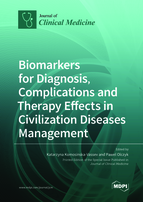Biomarkers for Diagnosis, Complications and Therapy Effects in Civilization Diseases Management
A special issue of Journal of Clinical Medicine (ISSN 2077-0383). This special issue belongs to the section "Endocrinology & Metabolism".
Deadline for manuscript submissions: closed (10 December 2021) | Viewed by 42053
Special Issue Editors
Interests: laboratory medicine; extracellular matrix; civilization diseases; biomarkers;
Special Issues, Collections and Topics in MDPI journals
Interests: biochemistry and pathobiochemistry of connective tissue;
Special Issues, Collections and Topics in MDPI journals
Special Issue Information
Dear Colleagues,
The prevalence of diseases of civilization, i.e., cancer, diabetes, obesity, and autoimmune diseases have shown an exponential worldwide rise in recent years. The development of molecular, biotechnology, and genetic tools has provided to the clinical practice valuable diagnostic tools based on new molecules, proteins, as well as genes, which are not only involved in the pathogenesis of civilization diseases but are also used as markers to assess the effectiveness of therapy or to predict development of complications. Today, a diversity of the available diagnostic tools have helped physicians to change the way of approaching civilization illness toward the concept of personalized medicine. In this Special Issue, we invite investigators to contribute either original research or review articles focusing on the role of new protein, molecular, and genetic markers that can be used for the diagnosis and monitoring of the progression of the several complications linked to civilization diseases as well as biomarkers useful in monitoring the effects of the implemented treatment. At the same time, we invite researchers to submit either original research or review articles having civilization diseases as the main topic focusing on the latest diagnostic tools and possible use of them as biomarkers for health and disease.
Prof. Katarzyna Komosinska-Vassev
Prof. Pawel Olczyk
Guest Editors
Manuscript Submission Information
Manuscripts should be submitted online at www.mdpi.com by registering and logging in to this website. Once you are registered, click here to go to the submission form. Manuscripts can be submitted until the deadline. All submissions that pass pre-check are peer-reviewed. Accepted papers will be published continuously in the journal (as soon as accepted) and will be listed together on the special issue website. Research articles, review articles as well as short communications are invited. For planned papers, a title and short abstract (about 100 words) can be sent to the Editorial Office for announcement on this website.
Submitted manuscripts should not have been published previously, nor be under consideration for publication elsewhere (except conference proceedings papers). All manuscripts are thoroughly refereed through a single-blind peer-review process. A guide for authors and other relevant information for submission of manuscripts is available on the Instructions for Authors page. Journal of Clinical Medicine is an international peer-reviewed open access semimonthly journal published by MDPI.
Please visit the Instructions for Authors page before submitting a manuscript. The Article Processing Charge (APC) for publication in this open access journal is 2600 CHF (Swiss Francs). Submitted papers should be well formatted and use good English. Authors may use MDPI's English editing service prior to publication or during author revisions.
Keywords
- Civilization diseases
- Biomarkers
- Health
- Disease
- Molecular pathways
- Diagnosis
- Monitoring the effects of treatment
- Prediction of the development of complications








